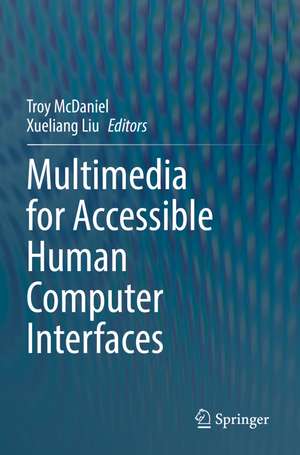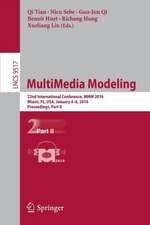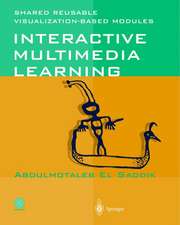Multimedia for Accessible Human Computer Interfaces
Editat de Troy McDaniel, Xueliang Liuen Limba Engleză Paperback – 28 aug 2022
Under Theme 1 “Vision-based Technologies for Accessible Human Computer Interfaces”, multimedia technologies to enhance access to interfaces through vision will be presented including: “A Framework for Gaze-contingent Interfaces”, “Sign Language Recognition”, “Fusion-based Image Enhancement and its Applications in Mobile Devices”, and “Open-domain Textual Question Answering Systems”. Under Theme 2 “Auditory Technologies for Accessible Human Computer Interfaces”, multimedia technologies to enhance access to interfaces through hearing will be presented including: “Speech Recognition for Individuals with Voice Disorders” and “Socially Assistive Robots for Storytelling and Other Activities to Support Aging in Place”. Under Theme 3 “Haptic Technologies for Accessible Human Computer Interfaces”, multimedia technologies to enhance access to interfaces through haptics will be presented including: “Accessible Smart Coaching Technologies Inspired by Elderly Requisites” and “Haptic Mediators for Remote Interpersonal Communication”. Under Theme 4 “Multimodal Technologies for AccessibleHuman Computer Interfaces”, multimedia technologies to enhance access to interfaces through multiple modalities will be presented including: “Human-Machine Interfaces for Socially Connected Devices: From Smart Households to Smart Cities” and “Enhancing Situational Awareness and Kinesthetic Assistance for Clinicians via Augmented-Reality and Haptic Shared-Control Technologies”.
| Toate formatele și edițiile | Preț | Express |
|---|---|---|
| Paperback (1) | 646.80 lei 43-57 zile | |
| Springer International Publishing – 28 aug 2022 | 646.80 lei 43-57 zile | |
| Hardback (1) | 653.21 lei 43-57 zile | |
| Springer International Publishing – 27 aug 2021 | 653.21 lei 43-57 zile |
Preț: 646.80 lei
Preț vechi: 808.50 lei
-20% Nou
Puncte Express: 970
Preț estimativ în valută:
123.76€ • 129.57$ • 102.41£
123.76€ • 129.57$ • 102.41£
Carte tipărită la comandă
Livrare economică 07-21 aprilie
Preluare comenzi: 021 569.72.76
Specificații
ISBN-13: 9783030707187
ISBN-10: 3030707180
Ilustrații: XIII, 307 p. 120 illus., 96 illus. in color.
Dimensiuni: 155 x 235 mm
Greutate: 0.45 kg
Ediția:1st ed. 2021
Editura: Springer International Publishing
Colecția Springer
Locul publicării:Cham, Switzerland
ISBN-10: 3030707180
Ilustrații: XIII, 307 p. 120 illus., 96 illus. in color.
Dimensiuni: 155 x 235 mm
Greutate: 0.45 kg
Ediția:1st ed. 2021
Editura: Springer International Publishing
Colecția Springer
Locul publicării:Cham, Switzerland
Cuprins
PART I: VISION-BASED TECHNOLOGIES FOR ACCESSIBLE HUMAN COMPUTER INTERFACES.- Chapter 1: A Framework for Gaze-contingent Interfaces.- Chapter 2: Sign Language Recognition.- Chapter 3: Fusion-based Image Enhancement and its Applications in Mobile Devices.- Chapter 4: Open-domain Textual Question Answering Systems.- PART II: AUDITORY TECHNOLOGIES FOR ACCESSIBLE HUMAN COMPUTER INTERFACES.- Chapter 5: Speech Recognition for Individuals with Voice Disorders.- Chapter 6: Socially Assistive Robots for Storytelling and Other Activities to Support Aging in Place.- PART III: HAPTIC TECHNOLOGIES FOR ACCESSIBLE HUMAN COMPUTER INTERFACES.- Chapter 7: Accessible Smart Coaching Technologies Inspired by Elderly Requisites.- Chapter 8: Haptic Mediators for Remote Interpersonal Communication.- PART IV: MULTIMODAL TECHNOLOGIES FOR ACCESSIBLE HUMAN COMPUTER INTERFACES.- Chapter 9: Human-Machine Interfaces for Socially Connected Devices: From Smart Households to Smart Cities.- Chapter 10: Enhancing Situational Awareness and Kinesthetic Assistance for Clinicians via Augmented-Reality and Haptic Shared-Control Technologies.
Notă biografică
Troy McDaniel is an Assistant Professor of Engineering in the Polytechnic School at Arizona State University. He is the Director of the Center for Cognitive Ubiquitous Computing and the HAPT-X Laboratory. His research interests span the areas of haptic interfaces, human-robot interaction, human-computer interaction, and smart cities. He is particularly interested in tactile vision sensory substitution and haptic human augmentation. He focuses on applications involving assistive, rehabilitative, and healthcare technologies for individuals with sensory, cognitive, or physical impairments. Within these applications, he explores new haptic interaction paradigms and novel mappings between modalities to convey information in alternative ways. He is also actively exploring challenges related to accessibility and health & well-being within smart city and smart living applications using person- and citizen-centered approaches. He has authored more than 50 peer-reviewed publications and co-edited Haptic Interfaces for Accessibility, Health, and Enhanced Quality of Life. He holds a bachelor’s and Ph.D. degree in Computer Science from Arizona State University.
Xueliang Liu is a Professor in School of Computer Science and Information Engineering in Hefei University of Technology, China. His research interests include multimedia retrieval, social media analysis and object detection. He has authored over 40 journal and conference papers in these areas. He has served as the area chair of ACM Multimedia, and on technical program committees of numerous multimedia and information retrieval conferences including ACM Multimedia (MM), ACM SIGIR, International Conf. on Multimedia Retrieval (ICMR) and International Conf. on Multimedia and Expo (ICME). He has received the outstanding service award at PCM 2018, the best reviewer award at PCM 2013, and the best demo award at ACM MM 2007. He has also been the program chair of the ACM workshop on Multimedia for Accessible Human Computer Interfaces, and the organizing chair of ICIMCS 2013, MMM 2016, and PCM 2018. He received his Ph.D and MSc from EURECOM France and USTC China in 2013 and 2008 respectively.
Textul de pe ultima copertă
The book Multimedia for Accessible Human Computer Interfaces is to be the first resource to provide in-depth coverage on topical areas of multimedia computing (images, video, audio, speech, haptics, VR/AR, etc.) for accessible and inclusive human computer interfaces. Topics are grouped into thematic areas spanning the human senses: Vision, Hearing, Touch, as well as Multimodal applications. Each chapter is written by different multimedia researchers to provide complementary and multidisciplinary perspectives. Unlike other related books, which focus on guidelines for designing accessible interfaces, or are dated in their coverage of cutting edge multimedia technologies, Multimedia for Accessible Human Computer Interfaces takes an application-oriented approach to present a tour of how the field of multimedia is advancing access to human computer interfaces for individuals with disabilities.
Under Theme 1 “Vision-based Technologies for Accessible Human Computer Interfaces”, multimedia technologies to enhance access to interfaces through vision will be presented including: “A Framework for Gaze-contingent Interfaces”, “Sign Language Recognition”, “Fusion-based Image Enhancement and its Applications in Mobile Devices”, and “Open-domain Textual Question Answering Systems”. Under Theme 2 “Auditory Technologies for Accessible Human Computer Interfaces”, multimedia technologies to enhance access to interfaces through hearing will be presented including: “Speech Recognition for Individuals with Voice Disorders” and “Socially Assistive Robots for Storytelling and Other Activities to Support Aging in Place”. Under Theme 3 “Haptic Technologies for Accessible Human Computer Interfaces”, multimedia technologies to enhance access to interfaces through haptics will be presented including: “Accessible Smart Coaching Technologies Inspired by Elderly Requisites” and “Haptic Mediators for Remote Interpersonal Communication”. Under Theme 4 “Multimodal Technologies for AccessibleHuman Computer Interfaces”, multimedia technologies to enhance access to interfaces through multiple modalities will be presented including: “Human-Machine Interfaces for Socially Connected Devices: From Smart Households to Smart Cities” and “Enhancing Situational Awareness and Kinesthetic Assistance for Clinicians via Augmented-Reality and Haptic Shared-Control Technologies”.
Under Theme 1 “Vision-based Technologies for Accessible Human Computer Interfaces”, multimedia technologies to enhance access to interfaces through vision will be presented including: “A Framework for Gaze-contingent Interfaces”, “Sign Language Recognition”, “Fusion-based Image Enhancement and its Applications in Mobile Devices”, and “Open-domain Textual Question Answering Systems”. Under Theme 2 “Auditory Technologies for Accessible Human Computer Interfaces”, multimedia technologies to enhance access to interfaces through hearing will be presented including: “Speech Recognition for Individuals with Voice Disorders” and “Socially Assistive Robots for Storytelling and Other Activities to Support Aging in Place”. Under Theme 3 “Haptic Technologies for Accessible Human Computer Interfaces”, multimedia technologies to enhance access to interfaces through haptics will be presented including: “Accessible Smart Coaching Technologies Inspired by Elderly Requisites” and “Haptic Mediators for Remote Interpersonal Communication”. Under Theme 4 “Multimodal Technologies for AccessibleHuman Computer Interfaces”, multimedia technologies to enhance access to interfaces through multiple modalities will be presented including: “Human-Machine Interfaces for Socially Connected Devices: From Smart Households to Smart Cities” and “Enhancing Situational Awareness and Kinesthetic Assistance for Clinicians via Augmented-Reality and Haptic Shared-Control Technologies”.
Caracteristici
Timely topic due to the rising popularity of accessibility and inclusion in human computer interfaces including the rapidly growing subfields of haptics and VR/AR Novel in that no other similar or recent text exists Noteworthy in that it brings together an international and multidisciplinary group of multimedia researchers to present how recent advancements in multimedia computing may solve grand challenges related to inaccessible human computer interfaces



















